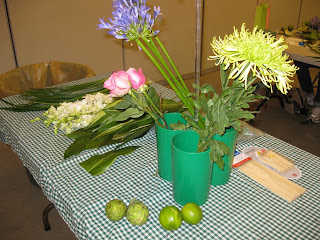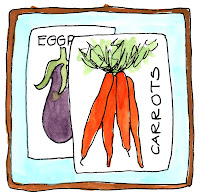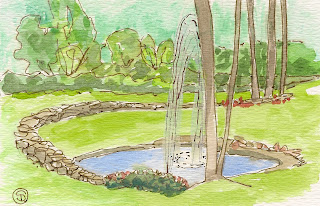Pediment/Pentimento
the flower show: Loyalist Legacy
Class 1 Pediment/Pentimento 4 Entries
A design staged on a fluted pedestal 42” high with a 14” square top. Design not to exceed 14” from center of pedestal top on either side. Viewed from all sides.
An often asked question is, "where do your ideas come from?" In
this case, I began with the dictionary. The alliterative class title contrasted two kinds of forms:
pediment, the geometric triangle of classical buildings and pentimento, which, in one meaning, means delicate interlacing of lines. This contrast of form of the solid and airy would be the basis of my design.
Materials:
a
sheet of oasis glued to Styrofoam (bought this years ago at a workshop and despaired of ever using it - haven't seen it for sale elsewhere, but also haven't looked)
1/2" wooden dowel
oval wooden 'plaque' (Michael's)
Styrofoam/oasis is 3.5" thick.
Cut dowel, screwed into the base.
Wanting to avoid a predictable, horizontal triangle, I shaped it vertically, deconstructing it from a pediment to a vertical triangle. The dowel is jammed into point of the triangle so it stands upright.
I found the resulting top, which was straight
across rather less than dynamic, so I added another smaller triangle (top, right) – this creates more interest, and takes the concept further from a literal idea. The long edge of this topmost piece becomes the
hydrated oasis.
The rather odd cut, barely seen in the top oasis, separates the part that is actually hydrated from the rest of the oasis on the form, and becomes the water source for plant material.
The plant material chosen would be lacey and open, suggesting a kind of tracery.
Plant materials are:
Aspidistra - long leaves used to cover triangle
Jasmine - lacy pink & white vines
Clematis - both large white & smaller pink
Nigella pods - love-in-a-mist pods color of clematis centers
The day before the show I bought my plant materials and conditioned them thoroughly, or thought I did. I took a first time chance on using the clematis as the show was only up for one day. In the end, they didn't fare very well....
Five bunches of Aspidistra leaves are used
to upholster the form. This was
the only part I practiced – several times – trying for as ‘clean’ a form as I
could get.
This was my first
attempt (right). I used the side 'seam' of the structure to line up the pinned leaves (see below also) and let them overlap each other on the front surface. The hardware store yields a plethora of interesting pins/nails to be used in modern designs. The secret is that their use needs to make sense from a design point of view and to use them precisely, otherwise they become a distraction. However....
As preciseness is not quite in my skill set, I decided on another method which would hide any pins I needed to do the job. Because the aspidistra leaves have a stiff spine, I separated the leaves (right of picture) down the spine. They have a
fat half and a narrower half (left). Discard the spine.
Starting at the top of the triangle overlap a leaf from left and from right to cover
the shape (left, above). Once you are about a third of the way – descending – one leaf half will fit from side to side. I
didn’t worry about the sides of the structure and their pins looking neat but just kept the tacks close to the
middle. Once both the front surfaces
were all covered, for the sides of the structure, put double stick carpet tape (Scotch brand) on the back of whole leaves (removing the spine where it starts to thicken), and overlapping the leaves vertically as in the drawing (right). The leaves on the front of the structure are placed starting at the top and going down overlapping each as you go. The sides of the structure are placed in reverse, beginning at the bottom and layering up. All of the leaves will last without water easily for several
days. It is harder to describe or draw than to do!
I did make rather a production of the base so that I wouldn't have to use a lot of gravel (Accent Decor) to fill it up. One can always take a LOT of gravel and just fill it up instead of doing it this way!
Base: 12”
square tin tray, sprayed black then a 12" x 12" styrofoam. Place the base on the styrofoam. Fill in with torn newspaper strips to raise the level and top it off with 12” X 12” piece of black paper. Finally the gravel...
At the show, the best laid
plans…….
The two
triangles did not fit together as well as they should and once the upper one was hydrated the whole design was quite top heavy. If
it didn’t sit straight, the rest of the design wouldn't matter at all. Wooden skewers held the two triangles together. Using more padded newspaper to level between the top triangle and the larger one, more aspidistra leaves were then slipped in to cover the gap (whew!).

Would that I had had a step stool when adding the tracery - it was was up high and hard to see the Oasis gap between the leaves in which to put the fragile stems. On reflection, it was almost like a crack In the pediment that sprouted vegetation.
“triangle/tracery”
Although I usually resist using a title/intent for my designs, I used this simple one as my intent.
The camaraderie of designers is infectious in these shows. We all mumble and stumble and help each other. Don't you think my fellow exhibitors in the class used luscious plant materials in gorgeous colors in their designs?
It was hard to photograph these without the distracting backgrounds of the lovely club. You can see that it was one part of a very lovely flower show. Congratulations to the Garden Club of Lawrence and the hard-working flower show committee!
Cheers!

















































